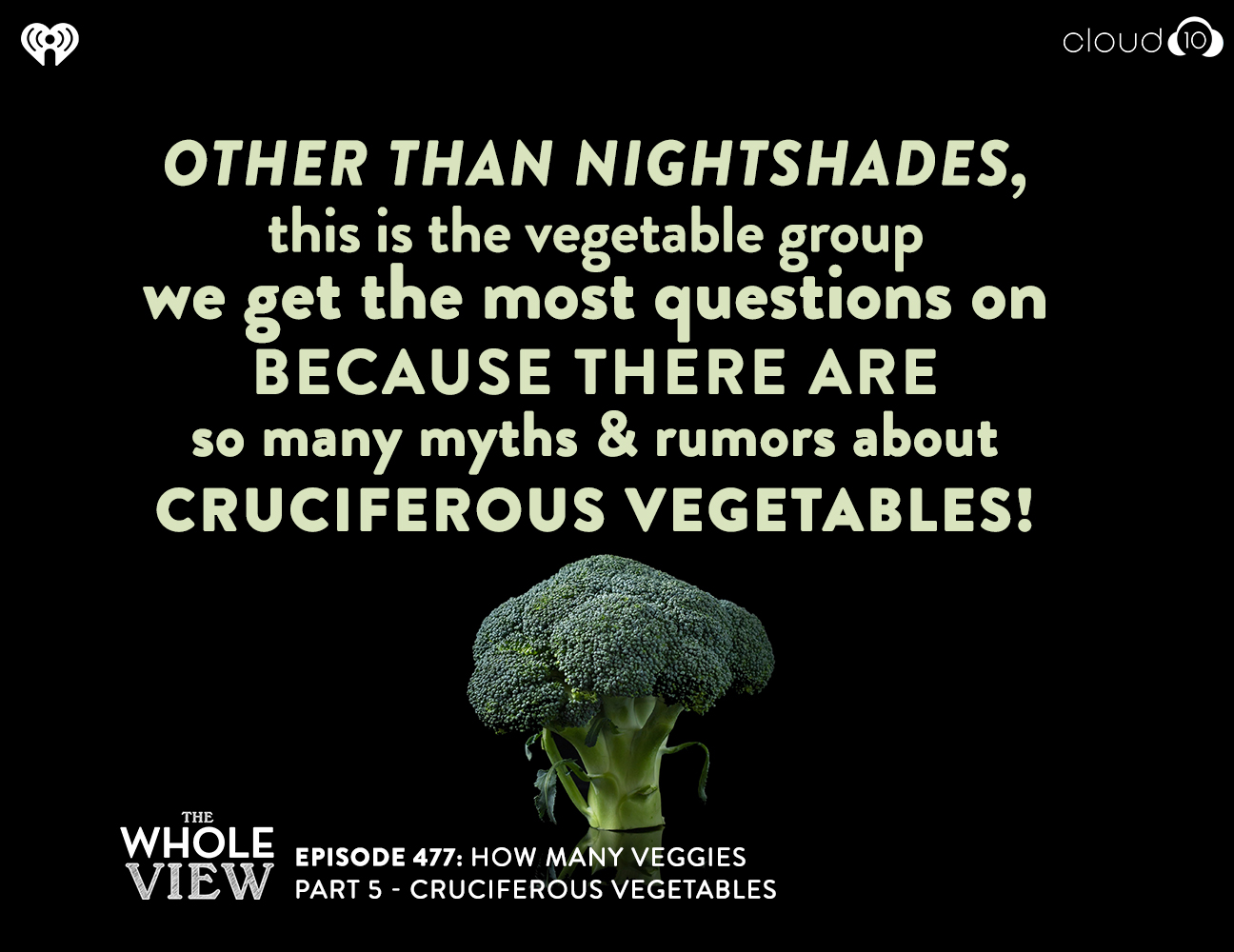
Welcome to episode 477 of The Whole View! This week, Stacy and Dr. Sarah dive into the science behind cruciferous vegetables, the best ways to eat them, and bust a few myths about this often misunderstood vegetable group.
If you enjoy the show, please review it on iTunes!
The Whole View, Episode 477: How Many Veggies Part 5 – Cruciferous Vegetables
Welcome back to episode 477! (3:19)
Listener Question
Hello Stacy and Dr.Sarah, I am a brand new listener, and I am so glad I found your podcast. I find myself laughing as much as I am learning, so thank you! I wanted to know your take on cruciferous vegetables because I’ve heard they should only be eaten rarely and never raw or juiced. Is there any truth to that and why would that be the case? Apologies if you have covered this on a past show. Thank you both for sharing your own struggles with us openly. I feel like I just gained two new friends and my Fridays just got even better!
-Thanks, Janet
Past shows in the series so far:
- How Many Vegetables Part 2: Lectins & Oxalates
- All About Vegetables
- How Many Vegetables Part 3: Souping vs. Smoothies
- How Many Vegetables Part 4: Powdered Veggies
Other popular veggie shows:
What Are Cruciferous Veggies?
Cruciferous vegetables are members of the Brassicaceae family. The term “cruciferous” comes from the Latin cruciferae, which means “cross-bearing” and refers to the shape of these plants’ flowers. (7:01)
Many of which are cultivars of a single species (Brassica oleracea): cabbage, Savoy cabbage, cauliflower, broccoli, Brussels sprouts, collard greens, kohlrabi, gai lan, and kale!
Additional crucifers include cultivars of Brassica rapa (turnips, napa cabbage, bok choy, and rapini), horseradish, watercress, garden cress, radish, daikon, collard greens, rutabaga, and mustard greens.
Here’s a handy-dandy list of cruciferous veggies:
- arugula (also known as rocket)
- bok choy
- broccoli & broccoli rabe
- broccoflower
- broccoli Romanesco
- Brussels sprouts
- cabbage
- canola (also known as rapeseed)
- cauliflower
- Chinese broccoli
- collard greens
- daikon
- field pepperweed
- flowering cabbage
- garden cress
- horseradish
- kale
- kohlrabi
- komatsuna
- land cress
- maca
- mizuna
- mustard
- radishes
- rapini (also known as broccoli rabe)
- rutabaga
- tatsoi
- turnips
- wasabi
- watercress
- wild broccoli
Benefits of Cruciferous Veggies
See Dr. Sarah’s article here! (12:03)
A systematic review looking at 95 studies evaluating fruit and vegetable intake showed eating 100 grams of cruciferous vegetables per day (about 1 serving), on average, led to
- 18% decrease in ischemic stroke,
- 17% decrease in hemorrhagic stroke,
- 16% decrease in total cancer risk, and
- 12% decrease in all-cause mortality and cardiovascular disease. Wow!
A pooled analysis of the Shanghai Women’s Health Study and Shanghai Men’s Health Study (encompassing 134,796 adults) found among individuals with the highest intake of cruciferous vegetables (28g for women and 34g for men in the lowest quintile vs. 166g for women and 208g for men in highest quintile, equivalent to 1.5 to 2 servings daily).
- 31% reduced risk for cardiovascular disease mortality and
- 22% reduced risk for total mortality
What The Science Says On Inflammation
One 2014 human trial also found that eating a high-cruciferous-vegetable (7 or 14 mg per kg BW per day = 4 to 8 servings for 150lb person) diet for 2 weeks reduced markers of inflammation associated with several disease states
- The biggest change was 20% reduction in the inflammatory cytokine interleukin-6 [IL-6]
- IL-6 plays a pathological role in chronic inflammation and autoimmunity
A variety of prospective cohort and case-control studies have found that overall cruciferous vegetable consumption (high vs. low, again, we’re talking 1-2 servings per day) is associated with a lower risk of:
- bladder cancer (up to a 20% lower risk),
- breast cancer (up to a 15% lower risk),
- colorectal cancer (up to an 18% lower risk),
- endometrial cancer (up to a 21% lower risk),
- gastric cancer (up to a 19% lower risk),
- liver cancer (up to a 27% lower risk),
- lung cancer (up to a 25% lower risk),
- ovarian cancer (up to an 11% lower risk),
- pancreatic cancer (up to a 21% lower risk), and
- prostate cancer (up to a 10% lower risk).
Nutrivore Score of Crucifers
Crucifers are the most nutrient-dense vegetables. Their average Nutrivore Score is 3591.
Dr. Sarah should mention that you can go to Nutrivore.com and sign up to get her Nutrivore Score Guide to Food Groups for free now!
And, this week’s new blog post is all about the Nutrivore Score.
| Nutrivore Score | Calories per 100g | |
| Broccoli | 3647 | 34 |
| Brussels Sprouts | 2454 | 43 |
| Cabbage, Green | 2307 | 24 |
| Cabbage, Red | 2271 | 31 |
| Cauliflower | 2213 | 25 |
| Kale | 4162 | 35 |
| Kohlrabi | 2011 | 27 |
| Radish | 3416 | 16 |
| Rutabaga | 1959 | 37 |
| Watercress | 9481 | 11 |
| Turnip | 1706 | 28 |
| Bok Choy | 4729 | 13 |
| Collards | 6329 | 32 |
| AVERAGE | 3591 | 27 |
What Nutrients Are Responsible For These High Scores?
For an average of 27 calories, a 1 cup serving of cruciferous veggies (2 cups for leafy greens like watercress, arugula, and kale): average
- Fiber 10%
- Vitamin C 51%
- Folate 11%
- Vitamin K 98%
- Polyphenols 27% (of 500mg daily)
- Vitamin B7 (biotin) 25%
- Glucosinolates 121% (of 15mg daily)
But note that 27 calories per serving are 1.35% of a 2000 calorie per day diet, so any nutrient that offers more than 1.35% DV is excellent!
- Calcium 6.3%
- Iron 4.4%
- Magnesium 4.9%
- Phosphorous 3.3%
- Zinc 2.3%
- Copper 6.9%
- Manganese 11.2%
- Selenium 1.6%
- B1 5%
- B2 6.4%
- B3 3.1%
- B5 5.2%
- A 8.5%
- Carotenoids 7.8%
- Vitamin E 4.2%
- ALA 3.6%
- Protein 6%
The only nutrients cruciferous vegetables aren’t a good source of are vitamin B12, choline, vitamin D, and functional fats.
Unsurprisingly, studies of cruciferous vegetable consumption in general also show they can significantly decrease levels of bacteria belonging to Rikenellaceae, Ruminococcaceae, Mogibacteriaceae, Clostridium, and unclassified Clostridiales.
These sulfate-reducing bacteria associate with intestinal diseases like ulcerative colitis and irritable bowel syndrome (IBS). So, lower levels may be a good sign!
A Reason to Eat Crucifers Raw
Isothiocyanates are the metabolites of glucosinolates, the biologically inactive compounds responsible for the distinctive flavor—including bitterness, sulfurous aroma, and pungency—of cruciferous vegetables. (28:15)
Isothiocyanates form when the vegetable is damaged (for example, sliced, crushed, or chewed), and the glucosinolates are able to mix with the vacuolar hydrolase enzyme myrosinase, which hydrolyses the glucosinolates into isothiocyanates.
Myrosinase is not heat-stable, so isothiocyanates are only formed when the raw vegetable is damaged.
We do have gut bacteria that produce myrosinase, so some isothiocyanates can form after we eat cooked cruciferous vegetables.
Isothiocyanates are particularly well-known for their anticancer properties, and some types of isothiocyanates can upregulate genes involved in protecting against DNA damage, inflammation, and oxidative stress, as well as increase the activity of phase II enzymes (such as quinone reductase and glutamate cysteine ligase) that help remove toxic substances and carcinogens from the body.
Isothiocyanate: The Most Famous Sulforaphane
Sulforaphane forms when myrosinase hydrolyses a glucosinolate called glucoraphanin into sulforaphane.
Researchers study sulforaphane for its ability to halt cancer cell growth, kill cancer cells, upregulate several phase II detoxification enzymes, and protect healthy cells from damage from environmental carcinogens.
It also upregulates a variety of protective antioxidant enzymes, including glutathione S-transferase(GST), heme oxygenase-1 (HO-1), quinone reductase (QR), UDP-glucuronosyltransferase (UGT).
Sulforaphane improves glycemic control in patients with obesity and poorly controlled type 2 diabetes and reduces hepatic gluconeogenesis.
It has powerful anti-inflammatory effects, delays the progression of osteoarthritis, and is cardioprotective.
Sulforaphane has also shown efficacy for neurodegenerative diseases, including Alzheimer’s, Parkinson’s, and multiple sclerosis.
It also has antimicrobial activity, including antibacterial effects sulforaphane suppresses the growth of Helicobacter pylori, the bacteria associated with gastric ulcers, and increased risk of gastrointestinal cancers
But What About Cooked?
As we discussed in Episode 424: 30 Fruits and Vegetables a Week?!, there are benefits to raw and cooked veggies, including raw vs. cooked fiber feeding different probiotic species.
Plus, it’s okay to eat crucifers cooked too because doing so increases the growth of bacteria that produce myrosinase!
In one randomized, controlled, crossover feeding study, subjects underwent several different two-week diets—including a control diet low in fiber and phytochemicals and a diet rich in cruciferous vegetables including cauliflower, cabbage, broccoli, and radish sprouts.
Intriguingly, the microbiota response to the cruciferous-vegetable-rich diet was significantly different from the control diet but was also unique.
In general, the bacteria Eubacterium hallii, Phascolarctobacterium faecium, Alistipes putredinis, and species belonging to Eggerthella appeared to be associated with cruciferous vegetable consumption. Still, the specific shifts in bacterial populations varied dramatically from person to person!
The researchers speculated that the individual-specific responses may have been related to baseline microbiota composition or that bacteria species belonging to different phylogenetic groups could have the same metabolic functions. Therefore, a variety of different microbiota profiles could emerge in response to the same cruciferous vegetable consumption.
The Myth that Crucifers are Goitrogens
People with thyroid problems often avoid crucifers or only eat them cooked, even though this family of veggies is associated with so many diverse health benefits! What gives? (38:00)
But first, some background!
The thyroid gland produces hormones that control metabolism and influence other essential systems in the human body, such as the cardiovascular system, the immune system, calcium homeostasis, and so much more!
People with autoimmune thyroid disorders and those with low thyroid function are often advised to avoid the consumption of cruciferous vegetables due to their goitrogenic properties.
A goitrogen is a substance that interferes with thyroid hormone synthesis, typically by blocking the activity of the enzyme thyroid peroxidase (TPO).
The health-promoting compounds, isothiocyanates and thiocyanates, derived via hydrolysis of glucosinolates found in crucifers, are known goitrogens.
When isothiocyanates or thiocyanates are consumed in large enough quantities, they reduce thyroid hormone formation via inhibition of TPO.
Despite a lack of human studies, early reports of goiters in iodine-deficient animals eating high amounts of cruciferous vegetables led to concern that this vegetable family should be off-limits for people with hypothyroidism.
What New Studies Say
Animal studies show that supplementation with broccoli or rutabaga sprouts reduces inflammation and oxidative stress in the thyroid, improving thyroid function even in iodine-deficiency-induced hypothyroidism.
In a 2018 study, a 7% freeze-dried rutabaga sprouts diet did not cause any significant changes in TSH, free T3, or free T4 in control (normal) rats.
Excitingly, the rutabaga-sprout-supplemented diet had a protective effect on thyroid damage (TSH decreased significantly) in iodine-deficient rats receiving a diet with iodine deficiency (RDI).
In contrast, rutabaga spouts enhanced hypothyroidism in sulfadimethoxine-treated rats (increased TSH and decreased both free T3 and free T4).
A follow-up study showed that rutabaga sprouts reduced oxidative stress on the thyroid in both iodine deficiency or sulfadimethoxine groups, in addition to a trend towards reduced proinflammatory cytokines (TNF-α and IL-6) and increased anti-inflammatory cytokine IL-10.
Importantly, this follow-up study showed that rutabaga sprouts had no hypothyroidism-enhancing effect in sulfadimethoxine-treated rats.
Another 2018 rat study examined a diet of 7% freeze-dried broccoli sprouts that did not cause any changes in thyroid function in control rats. It protects the thyroid in both sulfadimethoxine-treated rats and severe iodine deficiency!
In iodine-deficient rats, broccoli sprouts improved the antioxidant capacity of the thyroid while significantly reducing levels of the proinflammatory cytokine IL-6. Additionally, sulfadimethoxine-treated rats showed broccoli sprouts reduced TSH and increased free T3.
In addition, thioredoxin reductase activity significantly increased in response to sprouts ingestion.
Isothiocyanates and Thyroid Safety
A 2019 study in humans confirms that even high doses of isothiocyanates (from broccoli sprouts) are safe for the thyroid, even in the context of autoimmune thyroid disease.
In this study, a water extract of 3-day old broccoli sprouts (made simply by boiling the sprouts for 30 minutes) was treated with myrosinase to convert the glucosinolates into predominantly sulforaphane (an isothiocyanate).
Then, the extract was freeze-dried to form a powder and standardized based on its sulforaphane content. This powder was mixed with pineapple and lime juice to blind the participants could as to whether they were receiving the isothiocyanate-concentrated broccoli sprout extract, an untreated broccoli sprout extract (rich in the glucosinolate precursors but not isothiocyanates), or no broccoli sprout extract.
The broccoli sprout extract caused absolutely no change to TSH, free T4, or thyroglobulin compared to the placebo.
The percentage of participants who were seropositive for TPO and/or thyroglobulin antibodies at baseline was not statistically significantly different at 84 days (there was a trend toward a slight decrease, meaning fewer participants met the diagnostic criteria for Hashimoto’s thyroiditis at the end of the study compared to the beginning).
A similar trend toward a decrease in the percentage of participants with sub-clinical hypothyroidism was observed (again, not statistically significant).
A 2006 clinical trial found similar results. Participants consumed broccoli extract beverages three times per day for 7 days, and researchers saw no changes to TSH, total T3, or free T4.
These studies make a compelling case that cruciferous vegetables are a health-promoting food even for people with autoimmune thyroid disease and sub-clinical hypothyroidism, so go ahead and start eating!
Final Thoughts
Cruciferous veggies are some of the most nutrient-dense foods on the planet, and they are a unique source of specific phytonutrients that benefit our health!
Dr. Sarah makes a cruciferous vegetable almost every evening with dinner. Her go-to’s are broccoli, romanesco, cauliflower, kale, and bok choy.
She also recommends blanching vegetables and other cheats to hide the bitterness of veggies if you’re a bitter super-taster.
If you enjoyed this show, we invite you to join Stacy and Dr. Sarah over on Patreon for exclusive behind-the-scenes content about how Stacy and Sarah feel about the topics they discuss. Your subscription goes to support this show and gets you direct access to Stacy and Sarah.
We invite you to subscribe to this channel and the realeverything.com and thepaleomom.com blogs and newsletters.
Thanks so much for listened and we will see you next week!
Want more info on our Real Life? Healthy recipes, parenting tips, and general lifestyle stuff goes out in our Real Everything newsletter, join here.
Never want to miss a post, sale, or deal? Join my Healthy Inside & Out e-mail list for more info on non-toxic living and safer skincare!





